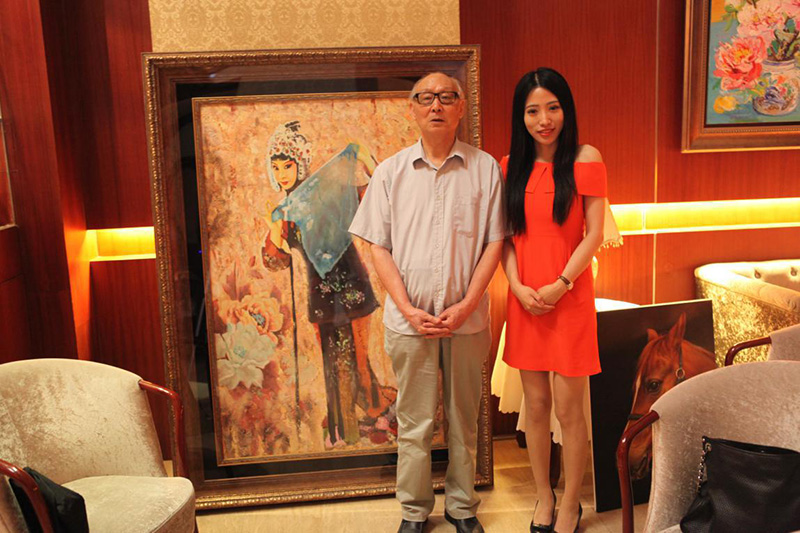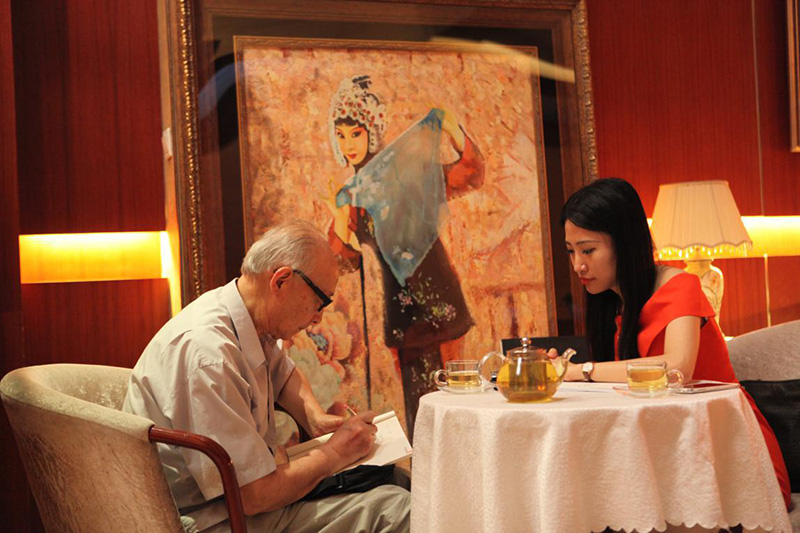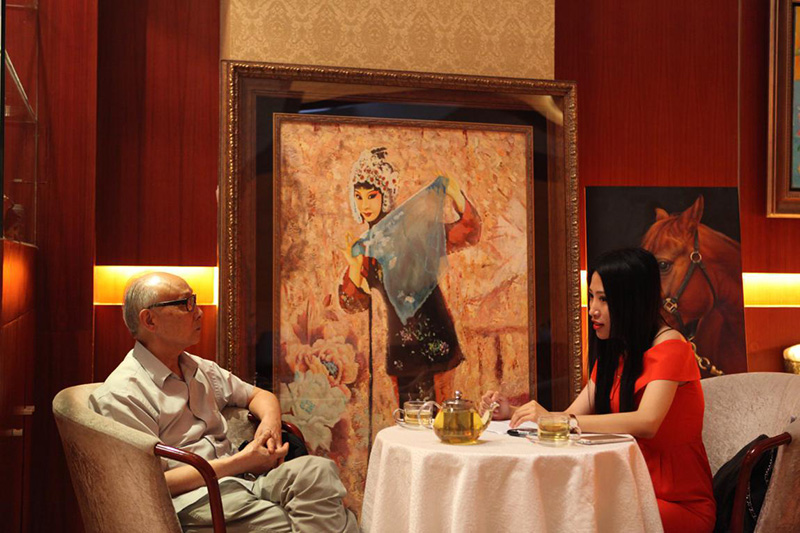
米巧铭在俄罗斯圣彼得堡列宾美术学院油画系接受过系统训练,掌握了写实绘画的造型基础。写实油画的基本功,一是造型结构,二是色彩修养,两者相辅相成,共同创造一种艺术境界。造型结构与绘画色彩,来自于客观物象的启示,以客观自然为基础,不是主观臆造,但又不是客观自然的机械模仿。客观自然的资源只有通过艺术家的机智灵活而又符合绘画原理的运用,方能获得良好效果。也就是说,面对客观自然,艺术家必须有敏锐的观察力和丰富的想象力,努力把握其形体特性和内在本质,产生某种感情体验,激发出艺术灵感与创作欲望,从而用点线面的造型并辅以色彩诉诸于画面。

米巧铭在俄国学习期间,一方面攻造型基础,接受素描、色彩、构图训练;另一方面,学习艺术史,在美术馆观摩历代经典名作,从中领会绘画创造原理,提高修养。正是得益于这两方面的努力,她回国后继续钻研,在绘画创作上取得了可喜的成绩。

米巧铭根据自己的兴趣和爱好,选择了京剧人物作为主要绘画题材,创作了“京彩”系列。京剧,中国文化的“国粹”之一,是一门综合性的艺术,其人物造型、服饰、行头,其唱腔和表演动作、姿态,其用民族乐器配合的音乐,共同组成妙不可言的动人心灵的艺术整体。用平面性的色彩语言呈现京剧人物,重点是表现京剧人物的神采和情韵。而神采与情韵,是古今中外艺术普遍的追求,更是中国传统写意艺术的精髓。京剧艺术和水墨画一样,以写意见长。米巧铭在国外学习期间,已经领会到西方写实艺术中的优秀作品之所以具有永恒的魅力,在于它在形的塑造中不失神韵,在这一点上与包括中国艺术在内的东方艺术有相通之处,只是中国艺术更为强调表现客观物象内在的精神以及艺术家的切身感受,更强调意象表现,更具写意精神。米巧铭原来热爱京剧,也有中国画的笔墨基础,她在“京彩”人物的创作中,力求把西画的人物造型结构、色彩语言和传统中国画平面写意技巧和京剧特有的装饰情趣融合于一体,形成她独特的艺术面貌。这是很有难度的艺术创造。她智慧地平衡油画块面造型、丰富色彩与京剧特有的装饰性之间的关系,构成形象整体感强而又不失书写性的画面。在前景人物刻画与背景处理上,米巧铭也表现出自己的才能,她或用与京剧人物性格相吻合的象征性符号或用装饰性的抽象色彩来衬映人物形象,组成令人神往的艺术境界。

用油画描写中国题材特别是传统京剧题材,又适当吸收传统中国画的技巧,要求艺术家必须具备中西文化艺术修养,使作品既保持油画语言特质,又具有中国传统艺术的文化内涵,这是有难度的。正是有难度,才使这种探索具有文化价值。米巧铭在“京彩”系列中所做的探索和取得的成绩,显示出她是一位有潜力的艺术家,我们期待她取得更新的创造成果。
邵大箴简介:1934年出生于江苏镇江,1960年毕业于俄罗斯列宾美术学院,当代中国著名美术理论家、国画家。现任中国美术家协会书记处书记、俄罗斯列宾美术学院名誉教授、中央美术学院美术史系教授
Appreciation of Qiaoming Mi’s Oil Painting “Opera Color” Series Shao Dazhen
Qiaoming Mi received systematic training in the oil painting department of Repin Academy of Fine Arts, St. Petersburg, Russia, which laid the modeling basis of realistic painting for her. The basic skills of realistic oil painting are the modeling structure and color cultivation which complement each other and jointly create an artistic state. Modeling structure and painting color are derived from the inspiration of objective images which takes the objective nature as the basis but not subjective imagination, though it is not the mechanical imitation of the objective nature. The resources of objective nature could not get a benign effect until they are utilized by artists through smart and professional painting principles. That is to say, in face of the objective nature, an artist must possess keen observation and rich imagination, strives to grasp at the external forms and internal features, creates some emotional experience, and gives rise to the artistic inspiration and creative desire, so as to produce paintings by the forms of point, line and plane, affiliated with colors.
Qiaoming Mi focused on two parts when she studied in Russia. On the one hand, she concentrated on the modeling basis, receiving such trainings as sketch, color and configuration. On the other hand, she learnt the artistic history, viewed and emulated all classics in the museums in a bid to comprehend the principles of creating paintings and improve her accomplishments. Just benefiting from her endeavors in the two aspects, she continued to study after returning to China. As a result, she has made satisfactory results in paintings.
Based on her own interest and hobby, Qiaoming Mi has chosen the opera figures as her major painting target. She has created the “Opera Color” series of paintings. As China’s cultural quintessence, Beijing Opera is an integrated art with its figure modeling, costume, singing skills, actions and gestures as well as the music accompanied by the folk music instruments being composed into marvelous and touching art combination. To represent the Beijing Opera figures with the two-dimensional color language is to emphasize the expression and charm of them. Expression and charm is the general pursuit of the Chinese And foreign arts throughout history, and it is all the more core of the Chinese traditional freehand art.
Just like the water and ink paintings, Beijing Opera also features the freehand style. While studying overseas, Qiaoming Mi had already understood that the reason why the Western realistic artworks have eternal charm is that they are not lacking in the internal soul inside their molding of external forms. This is in line with the Oriental art including the Chinese art. However, the Chinese art pays more attention to reproducing the objective images’ internal spirits and the artists’ feelings. It tends to emphasize the image demonstration as well as the spirit of freehand.
Qiaoming Mi has been very fond of Beijing opera, and possessed the water and ink foundation of the Chinese painting. During her creation of “Opera Colors”, she strived to blend the Western oil paintings’ figure structure, color language, the freehand skills of the traditional Chinese paintings, and the special decoration art of Beijing Opera, forming her special art form. This is a very difficult art creation. The relationship between her smart and balanced oil painting molding and rich colors, and the special decoration of Beijing Opera has jointly formed up integrated and free pictures. Qiaoming Mi has also skillfully demonstrated her talent in the foreground figure depiction and background disposal. She attempts to describe the figure images with tokens tallying with the Beijing Opera figures’ characteristics or with All are written in Chinese (to be translated))indd 10 2014.10.10 3:52:50 PM Beijing Opera Color---Qiaoming Mi Oil Painting Collection 10
decorative abstract colors, forming up dreamlike art realm. To depict the Chinese themes, especially the traditional Beijing Opera themes with oil paintings while properly absorb the skills of the traditional Chinese paintings requires the artist to possess both the Chinese and Western cultural and artistic accomplishments, making the works retain both the oil painting characteristics and the cultural connotations of the traditional Chinese arts. This is a tricky task. It is just because of this difficulty that makes this exploration culturally valuable. The explorations and achievements made by Qiaoming Mi in her “Opera Color” series indicate that she is a potential artist. We expect her to make greater achievements!